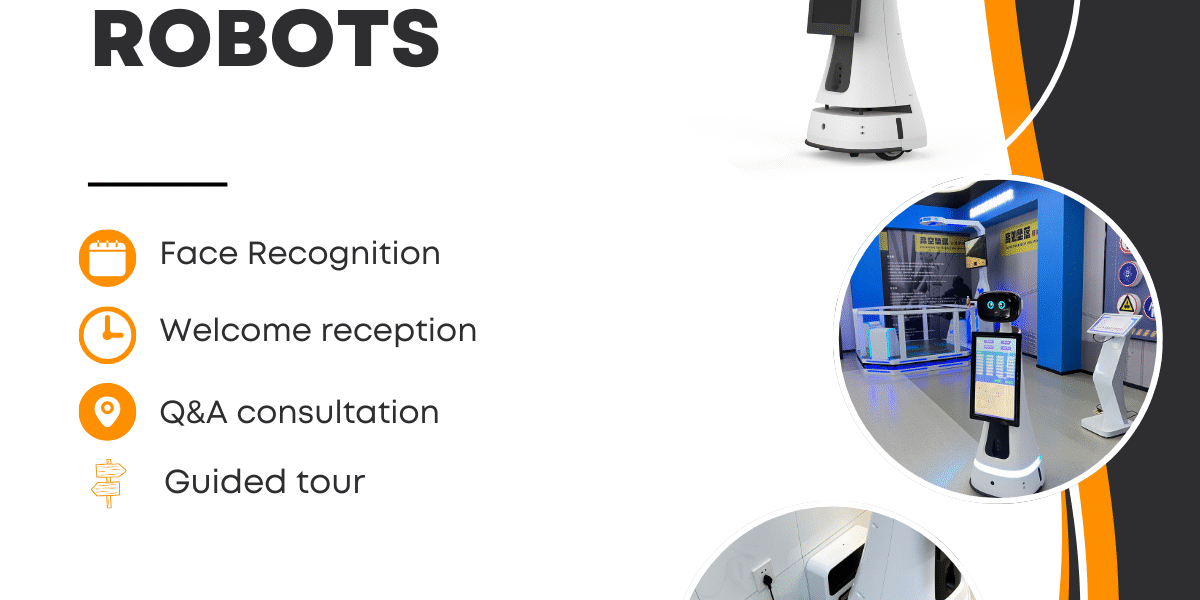As advancements in high-tech artificial intelligence continue to transform our lives, robots have become increasingly common in public and private sectors. One of the most prominent areas of this technological boom is the deployment of reception robots, which are more efficient and human-like in their services than traditional human receptionists. These smart assistants are now a staple in many environments, from hotels to hospitals, offering a unique blend of technology and service that attracts attention and streamlines operations.
What Are Reception Robots?
Reception robots are intelligent machines designed to perform tasks such as greeting, assisting, and interacting with customers in various settings. Equipped with voice interaction, facial recognition, and navigation systems, they provide efficient and customizable services to visitors, ensuring a pleasant experience without the limitations of human receptionists.
Key Functions of Reception Robots
- Cost-Efficient Operations: Once purchased, reception robots incur minimal ongoing costs compared to human staff. They perform repetitive tasks like greeting visitors, answering common queries, and guiding guests, freeing up human workers for more complex tasks. The long-term cost savings are significant, as companies no longer need to pay for wages, benefits, or breaks.
- Multi-Scenario Interaction: Reception robots are designed to handle various interaction scenarios. In settings like corporate lobbies, school libraries, or exhibition halls, they can engage in context-aware conversations with visitors, providing rich, dynamic content while maintaining smooth and efficient dialogue. They also support high-frequency question-and-answer templates, offering versatile options such as text, hyperlinks, audio, and video to cater to customer needs.
- Advanced Technology Integration: Equipped with facial recognition technology, reception robots can identify visitors, offering personalized services. They often incorporate OCR and ID card recognition to streamline visitor management. Furthermore, with laser LiDAR, ultrasound, and depth sensors, these robots navigate dense environments with ease, avoiding obstacles and ensuring smooth operations.
- Self-Servicing Abilities: One of the standout features of reception robots is their ability to operate autonomously. For instance, after completing their tasks, these robots can automatically return to their charging stations, ensuring they are always ready for the next task.
Expanding Market Applications
Reception robots are becoming essential across a range of industries due to their versatility and efficiency:
- Corporate Offices and Exhibition Halls: These robots can guide guests through customized routes, offer detailed explanations, and ensure a smooth visitor experience.
- Educational Institutions: In places like school libraries, reception robots engage in informative dialogues and provide helpful services to students and visitors.
- Public Spaces and Shopping Malls: Reception robots not only enhance customer service but also attract public attention, becoming an interesting social media feature as customers share their encounters with the robots.
- Hotels and Restaurants: With the hospitality industry becoming more competitive, robots add a unique touch to the customer experience by greeting guests, helping with check-ins, and assisting with queries.
Advantages of Reception Robots
- Cost-Effectiveness: In comparison to human receptionists, who require wages, insurance, and breaks, robots are a one-time investment with long-lasting benefits. They provide 24/7 service without fatigue or error, maximizing operational efficiency.
- Customer Engagement: Reception robots are excellent for drawing attention in public spaces. People are naturally curious about robots, and they often become a focal point for interaction. Additionally, in today’s social media-driven world, visitors often share their experiences with these robots, enhancing a brand’s visibility.
- Standardized Service: Human receptionists can be inconsistent, with performance influenced by mood or environmental factors. Reception robots eliminate these variables, providing consistent, high-quality service every time. Equipped with extensive libraries of pre-programmed responses, they maintain a professional demeanor, ensuring customers receive clear, accurate information.
- Error-Free Performance: While human receptionists might falter under pressure or handle complex tasks inefficiently, robots are designed to manage high volumes of interactions seamlessly. A single robot can easily handle the workload of multiple human receptionists, significantly boosting productivity.
Future of Reception Robots
With the ongoing development of smart technologies, the future looks bright for reception robots. The reception robot industry is poised to grow into a major high-tech field, driving the development of other industries and providing widespread support for future technological advancements. As automation continues to influence our daily lives, robots will play an increasingly prominent role in enhancing our work and service environments.
In conclusion, the integration of reception robots offers businesses a clear competitive advantage. They are cost-efficient, scalable, and capable of providing a standardized level of service that meets modern customer expectations. As more industries adopt these robots, their presence will only continue to grow, shaping the future of customer service.






